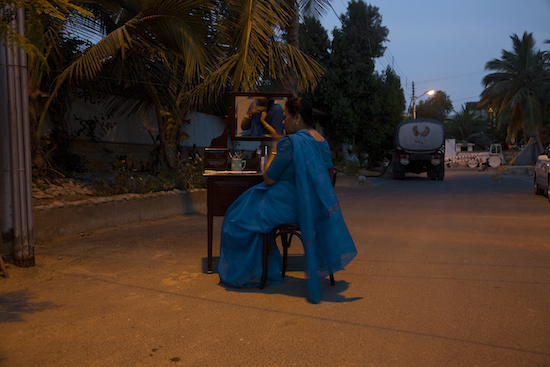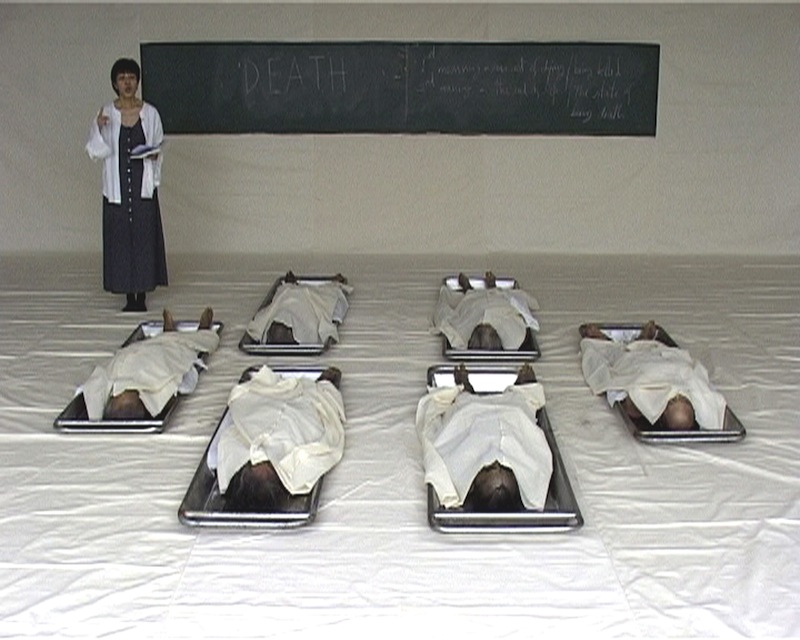
© » KADIST
Bani Abidi
The threshold in contemporary Pakistan between the security of private life and the increasingly violent and unpredictable public sphere is represented in Abidi’s 2009 series Karachi . These staged photographs were shot against the backdrop of the city’s empty streets at sundown during the holy month of Ramadan. During this time, Muslims fast and retreat indoors, leaving the city eerily empty.

© » KADIST
Tuan Andrew Nguyen
This work presents the image of an immolated monk engraved on a baseball bat. The flames surround him eroding the extremity of the bat. The delicate sculpture refers to the sacrifice of the Buddhist monk, Thich Quang Duc, who immolated himself on June 16th 1963, in reaction to the discrimination and the repressive politics of the Diem Catholic regime (regime installed by the Americans) towards the Buddhists.

© » KADIST
Danh Vo
Good life (2007) is an installation displaying letters, documents, photographs and objects from a man named Joseph Carrier, and appropriated by artist Danh Vo. The installation features a series of small square vitrines, inset, dark and precisely spot-lit. Inside these are framed photographs, mostly black and white, of young Asian men, taken, as the titles on the neat brass name plates tell us, in Vietnam in the 1960s and early 1970s.

© » KADIST
Bani Abidi
The perceived effortlessness of power, projecting above experiences of labored subordination is examined in Death at a 30 Degree Angle by Bani Abidi, which funnels this projection of image through the studio of Ram Sutar, renowned in India for his monumental statues of political figures, generally from the post-independence generation. In a contemporary Indian society beholden by strongmen, Abidi uses Sutar’s studio to fictionalize a sculptor producing commemorative works for populist, preening figures, surrounded by the likenesses of idolized politicians of the post-colony. Abidi’s video presents one such aspirational bureaucrat, trailed by a cadre of lackeys who fawn over the varying statues that are laboriously carted out for his approval.

© » KADIST
Bani Abidi
The threshold in contemporary Pakistan between the security of private life and the increasingly violent and unpredictable public sphere is represented in Abidi’s 2009 series Karachi . These staged photographs were shot against the backdrop of the city’s empty streets at sundown during the holy month of Ramadan. During this time, Muslims fast and retreat indoors, leaving the city eerily empty.

© » KADIST
Clarissa Tossin
Clarissa Tossin’s film Ch’u Mayaa responds to Frank Lloyd Wright’s Hollyhock House (constructed 1919–21) in Los Angeles, an example of Mayan Revival architecture. By re-appropriating the structure as a temple and imbuing it with a dance performance based on movements and postures found in ancient pottery and murals, the choreography takes its influence from the house’s design and the body positions on ancient Maya ceramics and buildings. A pulse, breathing, and a pre-Columbian clay flute are among the sounds on the soundtrack.

© » KADIST
Clarissa Tossin
In Fordlândia Fieldwork (2012), Tossin documents the remains of Henry Ford’s rubber enterprise Fordlândia, built in 1928 in the Brazilian Amazon to export cultivated rubber for the booming automobile industry. When his rubber trees died from disease and his primarily indigenous workforce revolted, his enterprise went busts within a few short years. Ford never faulted his own planning, but instead blamed the “inhospitable” Brazilian landscape.

© » KADIST
Jeffrey Vallance
Vallance’s Rocket is a vibrant picture in which masses of color and collage coalesce into a central vehicle, yet the whole surface seems lit with the roar of space travel. This varied use of media has enabled the artist to bring all of the life, energy, and objects he works with into a single image.

© » KADIST
Xu Tan
Drawing & Print (Drawing & Print)
Shanghai Biennale, Awaiting Your Arrival is an appropriation of the posters made to promote biennial art exhibitions. Displayed alongside the marketing posters of official biennials (Shanghai, Berlin, Venice, etc.) Displayed alongside the official marketing materials of biennials (Shanghai, Berlin, Venice, etc.)

© » KADIST
Araya Rasdjarmrearnsook
The Class (2005) by Araya Rasdjarmrearnsook challenges the viewer’s personal sense of morality and tolerance by depicting a classroom from hell. In the video, a woman, dressed in black with a white over shirt, stands in front of a long blackboard. The classroom’s rear walls and floor are covered in taut white fabric, given the room the sinister appearance of a sanitarium or a crime scene.

© » KADIST
Ximena Garrido Lecca
Destilaciones ( Distillations , 2014) is an installation composed of a group of ceramic pots, presented on the floor and within a steel structure. Copper pipes run through the perforated ceramics, evoking the design of an oil purifier. The work is a direct reference to the history of the Peruvian coastal town of Lobitos.

© » KADIST
Xu Tan
Drawing & Print (Drawing & Print)
Biennale, Dog is an appropriation of the posters made to promote biennial art exhibitions. Displayed alongside the official marketing materials of biennials (Shanghai, Berlin, Venice, etc.) Xu’s works provide a satiric and provocative alternative to the official system and make publicly visible images of many realities.

© » KADIST
Danh Vo
The work “Les Fleurs d’intérieur” (which gives its name to the exhibiton presented at Kadist Art Foundation from May 30 to July 13, 2009) is a brass plate engraved with the inventory list of the works included in the show. From this moment, Dahn Vo will use this brass plates as a systematic element for all his exhibitions.

© » KADIST
Cildo Meireles
Meireles, whose work often involves sound, refers to Sal Sem Carne (Salt Without Meat) as a “sound sculpture.” The printed images and sounds recorded on this vinyl record and it’s lithographed sleeve describe the massacre of the Krahó people of Brazil. The piece draws on Meireles’s first-hand contact with many indigenous groups through his father’s work with the Indian Protection Service. The recordings on the LP contain narrative accounts of massacres of native peoples, as well as indigenous music and rituals.
Bani Abidi
Bani Abidi’s practice deals heavily with political and cultural relations between India and Pakistan; she has a personal interest in this, as she lives and works in both New Delhi and Karachi...
Danh Vo
- location: Berlin, Germany
- year born: 1975
- gender: male
- nationality: Vietnamese and Danish
- home town: Ba Ria, Vietnam
Clarissa Tossin
- location: Los Angeles, California
- year born: 1973
- gender: female
- nationality: Brazilian
- home town: Porto Alegre, Brazil
Xu Tan
- location: Amsterdam, Netherlands
- year born: 1966
- gender: female
- nationality: Dutch
- home town: Pekan Baru, Indonesia
Ximena Garrido Lecca
- location: London, United Kingdom
- year born: 1980
- gender: female
- nationality: Peruvian
- home town: Lima, Peru
Araya Rasdjarmrearnsook
- location: Chiang Mai, Thailand
- year born: 1957
- gender: female
- nationality: Thai
- home town: Trad, Thailand
Tuan Andrew Nguyen
Tuan Andrew Nguyen is an artist and filmmaker, one of the three founders of The Propeller Group created in 2006...
Cildo Meireles
- location: Rio de Janeiro, Brazil
- year born: 1948
- gender: male
- nationality: Brazilian
- home town: Rio de Janeiro, Brazil
-
1970-1979
Cildo Meireles
1975Meireles, whose work often involves sound, refers to Sal Sem Carne (Salt Without Meat) as a “sound sculpture.” The printed images and sounds recorded on this vinyl record and it’s lithographed sleeve describe the massacre of the Krahó people of Brazil...
Jeffrey Vallance
1978Vallance’s Rocket is a vibrant picture in which masses of color and collage coalesce into a central vehicle, yet the whole surface seems lit with the roar of space travel...
-
2000-2009
Xu Tan
Drawing & Print
2000(Drawing & Print) Shanghai Biennale, Awaiting Your Arrival is an appropriation of the posters made to promote biennial art exhibitions...
Xu Tan
Drawing & Print
2003(Drawing & Print) Biennale, Dog is an appropriation of the posters made to promote biennial art exhibitions...
Araya Rasdjarmrearnsook
2005The Class (2005) by Araya Rasdjarmrearnsook challenges the viewer’s personal sense of morality and tolerance by depicting a classroom from hell...
Bani Abidi
2008The threshold in contemporary Pakistan between the security of private life and the increasingly violent and unpredictable public sphere is represented in Abidi’s 2009 series Karachi ...
Bani Abidi
2008The threshold in contemporary Pakistan between the security of private life and the increasingly violent and unpredictable public sphere is represented in Abidi’s 2009 series Karachi ...
-
2010-2019
Tuan Andrew Nguyen
2012This work presents the image of an immolated monk engraved on a baseball bat...
Bani Abidi
2012The perceived effortlessness of power, projecting above experiences of labored subordination is examined in Death at a 30 Degree Angle by Bani Abidi, which funnels this projection of image through the studio of Ram Sutar, renowned in India for his monumental statues of political figures, generally from the post-independence generation...
Clarissa Tossin
2012In Fordlândia Fieldwork (2012), Tossin documents the remains of Henry Ford’s rubber enterprise Fordlândia, built in 1928 in the Brazilian Amazon to export cultivated rubber for the booming automobile industry...
Ximena Garrido Lecca
2014Destilaciones ( Distillations , 2014) is an installation composed of a group of ceramic pots, presented on the floor and within a steel structure...
Clarissa Tossin
2017Clarissa Tossin’s film Ch’u Mayaa responds to Frank Lloyd Wright’s Hollyhock House (constructed 1919–21) in Los Angeles, an example of Mayan Revival architecture...